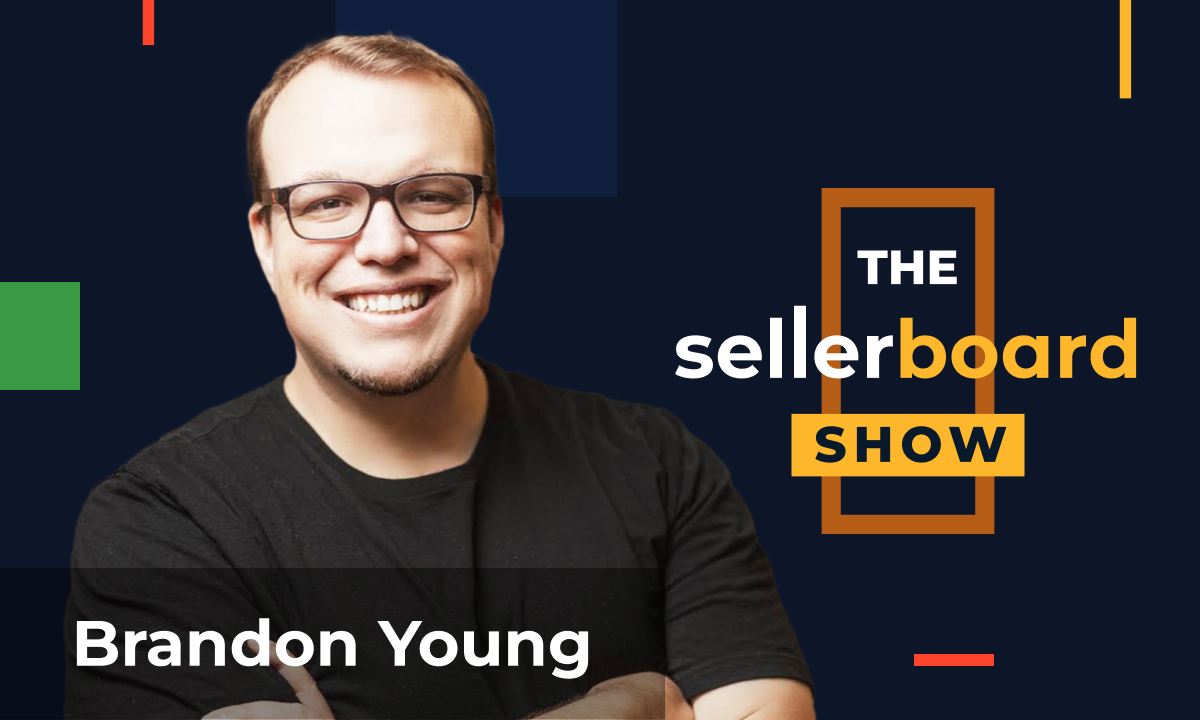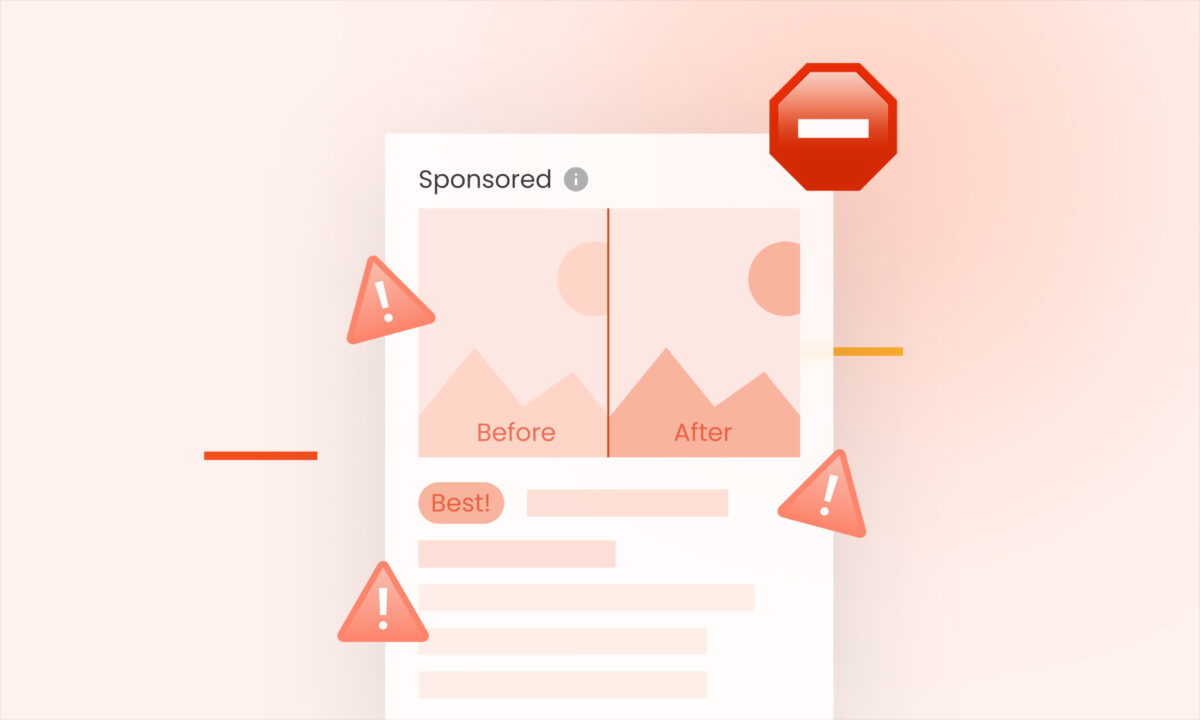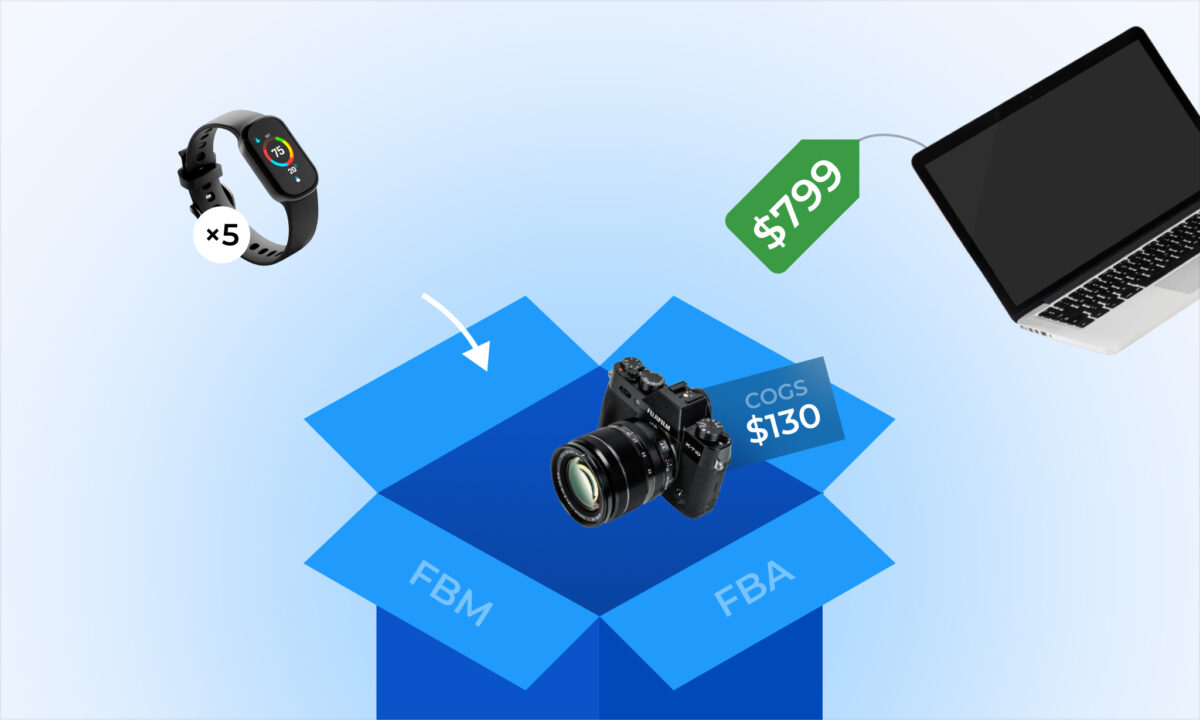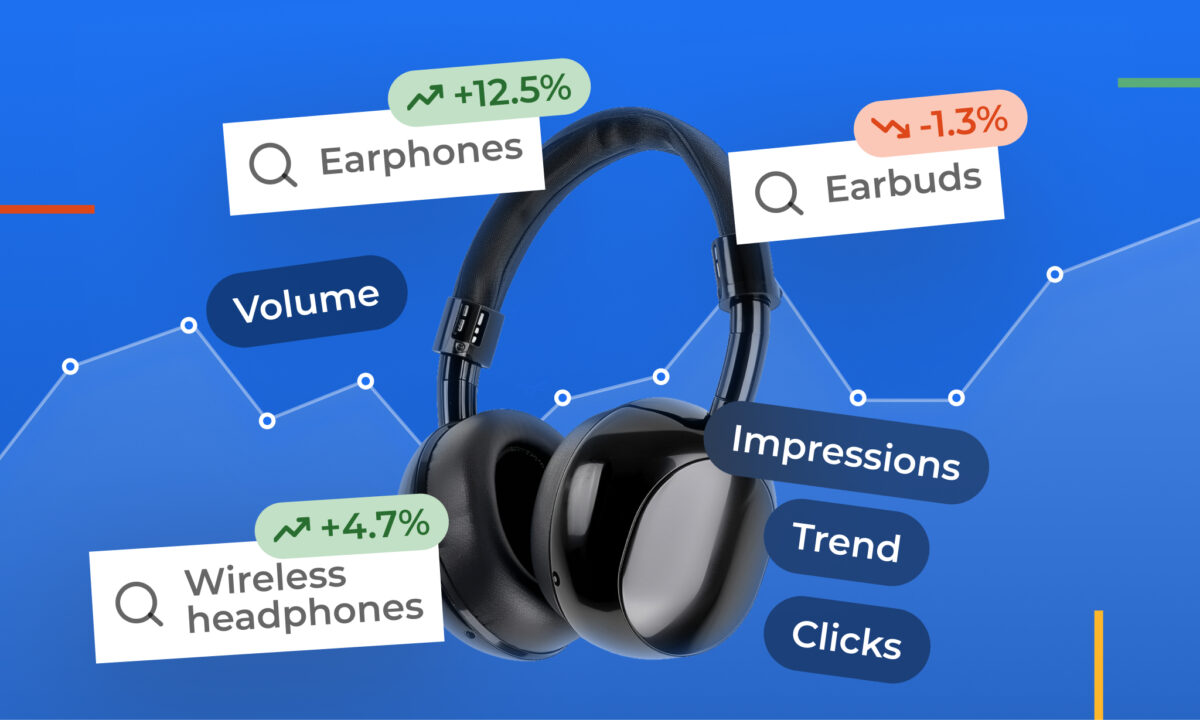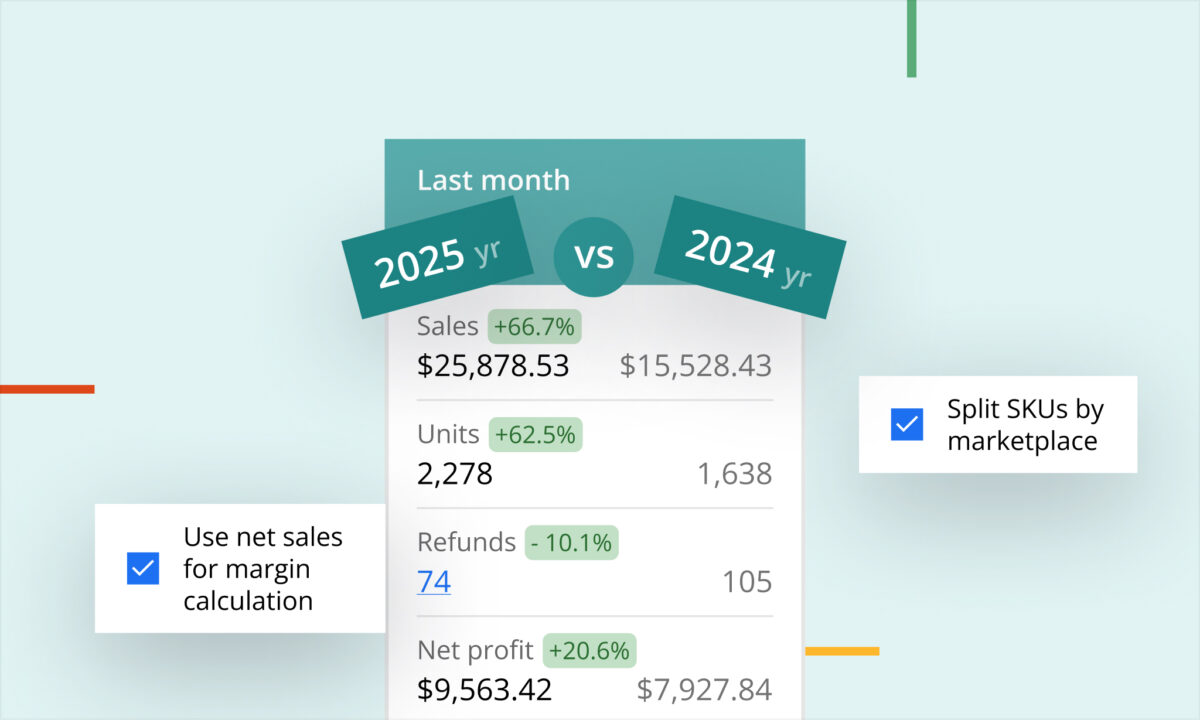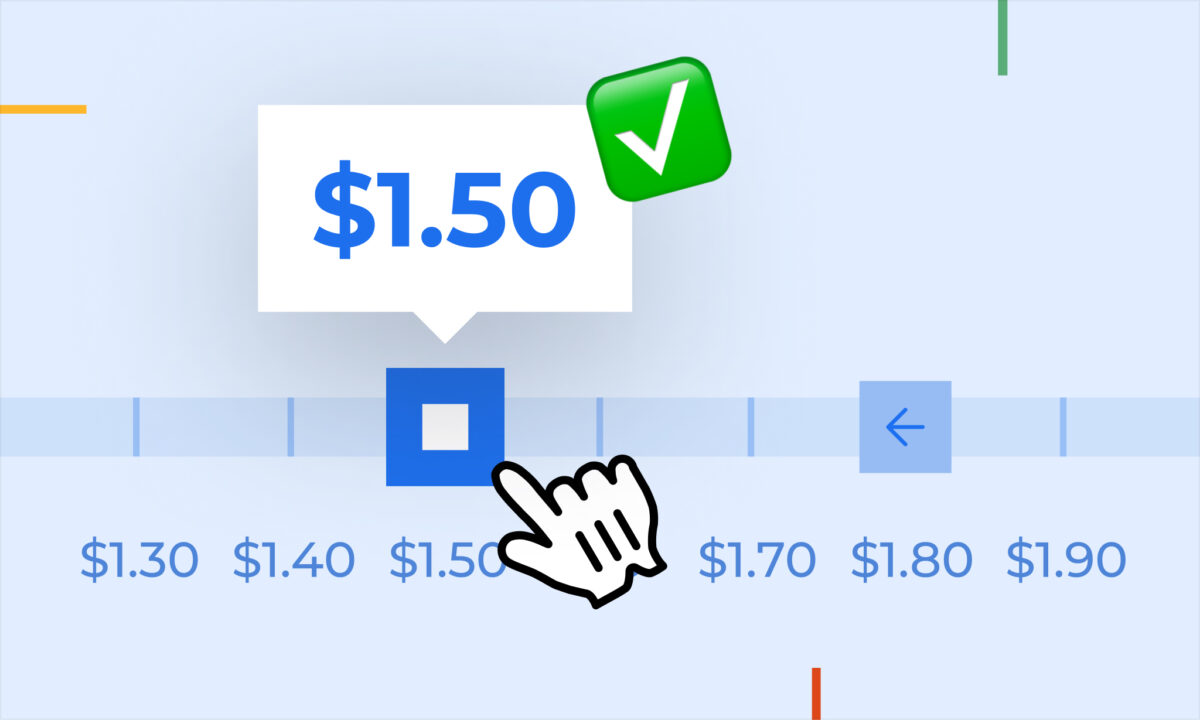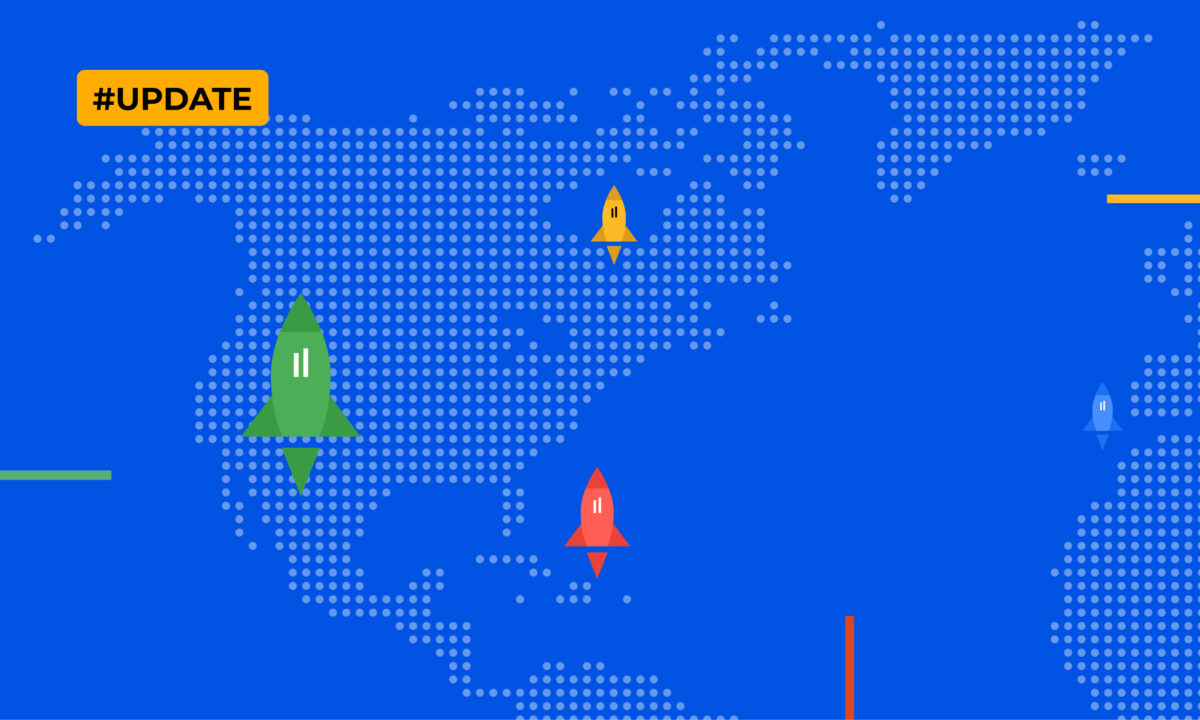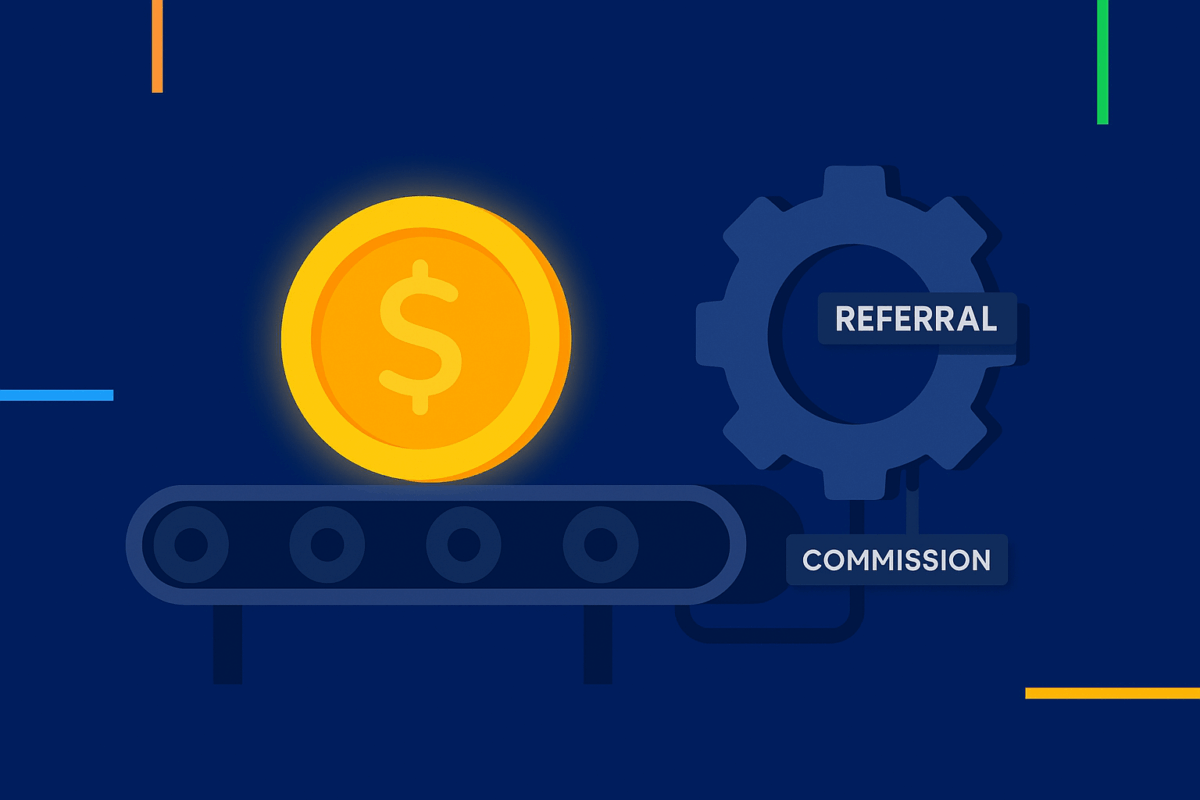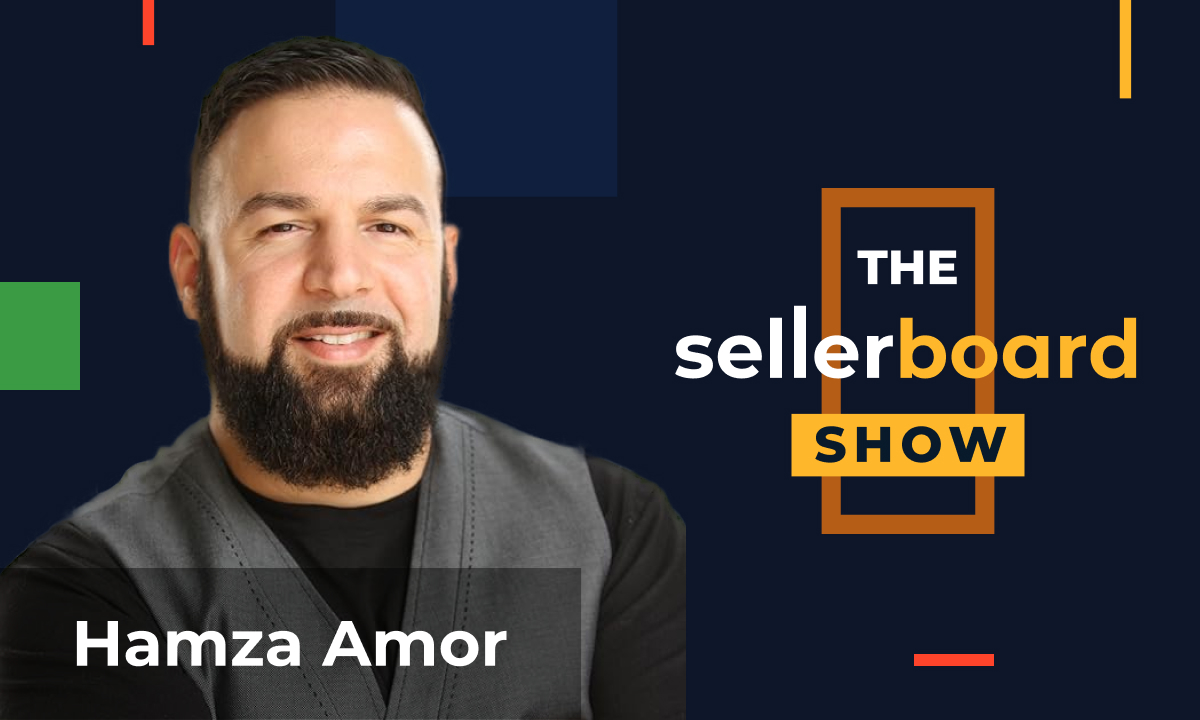Our guest on the sellerboard show was Brandon Young – Amazon SEO expert, 8 figure seller and CEO at Data Dive & Seller Systems – Amazon private label course.
Contents:
- products selection based on keywords;
- toy brands;
- tips for 6 figure sellers in 2023;
- pipeline of product’s lifeline;
…and much more!
Watch the full version of the interview here.
Speaker1: [00:00:07] Hello, everybody. Welcome. This is Fernando, your host for the sellerboard show on YouTube. I have a very special guest for you today. His name is Brandon Young. He’s from Data Dive and from Seller Systems. But before we start the interview, I need to ask you a favor. Go to sellerboard.com. If you haven’t already, click on demo play with the software. We prepared everything that you need. To run your Amazon store. It’s almost impossible to run your Amazon store without sellerboard. It’s going to give you profitability by day. Yesterday, this month, forecasting it’s going to give you a tacos per product, inventory, emails, everything that you need. It’s there for you. So before you watch the interview, celebrate.com, click on them, play with the software. I’m sure you’re going to like it. Thank you, guys. I’ll see you at the end. Bye bye. Welcome, everybody. Have a special guest for you today. His name is Brandon Young. He lives here right next to me in Miami. And he’s the CEO of Data Dive and from Seller Systems. Brandon, thank you so much for having us.
Speaker2: [00:01:27] Oh, thank you for having me, man.
Speaker1: [00:01:30] Thank you so much. Was excited to talk to you. I saw that you were speaking at Prosper and I was like, We have to interview Brandon. So and I didn’t know you lived here in Miami, so that was a nice surprise.
Speaker2: [00:01:44] Yeah. We’re neighbors, man. Uh, how long have you been in Miami?
Speaker1: [00:01:50] Uh, nine years now. What about you?
Speaker2: [00:01:54] So I’ve been in South Florida. I was born and raised in Hollywood like my whole life. Okay.
Speaker1: [00:01:59] Native. Oh, one of a few. Yeah, absolutely. Okay. All right. Let me get started. Brandon, please tell us your story. Let’s start with your story.
Speaker2: [00:02:12] Oh, from the beginning. So, yes.
Speaker1: [00:02:16] Beginning Hollywood.
Speaker2: [00:02:19] Yeah. Born in Hollywood, September 20th, 1981. I’m an old man now. I’m 41.
Speaker1: [00:02:24] So you were. Oh, I can’t believe you were my age. I’m also 41. What’s your birthday again?
Speaker2: [00:02:30] September. September 22nd.
Speaker1: [00:02:32] Oh, I’m three months older than you. Gotta pay some respect.
Speaker2: [00:02:36] Yeah, my elder. I’ll just call you. I’ll call you Abuela. From now on, we’ll send you off. Love it. Yeah, love it.
Speaker1: [00:02:47] So we have. We have a very good year in 81.
Speaker2: [00:02:51] Yeah, very good year. Good vintage. So good vintage. Yes, I. You know, I came up in a family of entrepreneurs, so my, my, my my grandfather had a business construction supply business. Before I was born, my parents owned a couple restaurants and they moved down to help in the construction supply business. My grandfather had gotten sick and so they closed the business. My parents always wanted to reopen it, and so they worked for a few years. I think right after Hurricane Andrew hit in 1992, I think my parents reopened the business. And so I grew up really around. Understanding how to handle inventory and employees and supply chain. And so I was helping in the warehouse, just I was a grunt. I was sweeping and I was just paying attention and learning. After high school. I played golf in high school and I played golf in college for Nova. And unfortunately and I started right out of college. I worked for Morgan Stanley. I got my degree in finance, and then I went and I left and I helped my family business. My father got sick, passed away. We sold the business in 2007, 2008, and I decided I wanted to get into entrepreneurship. I wanted to stay in entrepreneurship. So I went back to school for my MBA and entrepreneurship. I didn’t finish. I was a I’m a few classes short, but I started a venture capital club and I started meeting other entrepreneurs, other investors.
Speaker2: [00:04:42] I invested in a couple companies. And I met my now wife at a forum in West Palm Beach for angel investors. And she was she has two degrees in computer science. She was working on her PhD in computer science. And she was she was interested in leaving the PhD program to start a business, potentially. And so she and I started working together to maybe start a business and then fell in love. I’m me first. I fell in love way before she did. And. We started. Once we started officially dating, we decided to start a business together and we discovered FBA. So it was it was an incredible journey because we had looked at technology companies like when before there were very many food delivery services. We were looking at doing something like a GrubHub. We were looking at, you know, all of these very technical, you know, software type platforms, SaaS and. All of them were very expensive to do, but we were testing them through a methodology called Lean Startup. It’s where you you talk, you talk to the the potential customers first before you waste a lot of money building something that people don’t want, Right. Or that they won’t switch to. And so we went through a bunch of ideas that weren’t very good, but to me was an obvious win because I come from that supply chain and that overhead background, and I knew what it cost to have a warehouse, to have a lot of inventory and to manage employees to put stuff in boxes and how time consuming that is.
Speaker2: [00:06:29] And they let you, you know, at Amazon, they let you leverage. All of their billions of dollars in infrastructure, and they’ll do all of that for you so you can focus on scaling the business and said, this is the most scalable business model I’ve ever seen. We probably should look into this. And so we did. And within two months of starting it, we were doing six figures in revenue. We had found we had found suppliers for liquidation items like cell phone cases. We had I had gone back to my contacts with construction supplies and we were selling DeWalt tools, Makita tools, Milwaukee tools, and we were making decent money right away. But then Amazon started gating some of the brands and making it so that we couldn’t sell some of them like Kate Spade and DeWalt. And so we we looked for another opportunity within FBA and with with my wife being from China, we still weren’t married yet, but from with her being from China. I thought it was pretty ridiculous that we weren’t doing private label. We had a huge advantage with her being able to manage supply chain and deal with suppliers, get samples and.
Speaker3: [00:07:42] Mhm.
Speaker2: [00:07:43] So we got on a plane in April of 2016. And we went to our first Canton Fair and we came back. We launched our first product and private label. Pretty. We chose some pretty bad ones that, you know, we had some wins, we had some losses, but we learned a lot of lessons. Um, one of them I have sitting behind me. So it’s funny because I have behind me, I have a Bluetooth speaker. We did this. We did this little waterproof Bluetooth speaker. We had a bunch of these in different colors and we had the cell phone cases that we were selling. And we found, like, these case-mate brilliant cases. And it was. When we so since we were doing the liquidation on the electronics and the cell phone cases, we decided to go into electronics with private label. And at that time, Shenzhen was really starting to hit, you know, fifth gear like they the manufacturers there, were really starting to learn how to sell on Amazon. And they were becoming very aggressive because the Chinese government enacted a program where they would get a percentage of their exports. So they were getting a kickback from the government. And so they were willing to to sell at very small margins. So even when we had a winner and we launched it, well, we started losing to them because they kept lowering their prices.
Speaker3: [00:09:16] Mhm.
Speaker2: [00:09:17] So we decided to look at other categories. We learned a lot from products that we selected that didn’t sell well. We had some real big failures that, you know, we set down and we really analyzed to figure out why. And some of those those failures led us to really develop a data based approach to keyword selecting products based on keywords, to understand how competitors are currently getting their sales. And that was the biggest the biggest breakthrough for us was to to really always ask the question, how are the current sellers getting their sales? And if you can answer that question. Then you can answer the next question, which is can you duplicate it or do better than them? And and then. Then the last question is kind of like, is there a profit to beat them? Right. Like like if you if you beat them, is there a profit? And if you check Yes. To those boxes, then you should do that. You should do that widget, right? You should do that product. So when we first started, we had all these different brands because it didn’t matter to me what category the product was in. If I could do better than the competition, then I wanted to do that product, especially if there was a nice margin. So we ended up with like eight brands within a couple of years. And by 2018, I looked at her, I looked at my wife and I said, you know, we should I really like toys. They’re very difficult for most people because the keywords are very sometimes very abstract or very, very generic or very difficult to find the keywords. And we’re good at that. We’re very, very good at that. So I want to spend more time focusing on toys. And so we’re five years later and our toy brand did 19 million last year.
Speaker1: [00:11:02] And nice. Congratulations.
Speaker2: [00:11:04] Thank you. Uh, this year I think we still have a few brands and travel and a couple other categories, but our goal is to do about 35 million this year total with all of our brands.
Speaker3: [00:11:14] Nice.
Speaker1: [00:11:15] Very good. Congratulations. Very nice. Thank you. And also, what year would you say you started selling on Amazon?
Speaker2: [00:11:31] 2015 was the first year when we did wholesale and liquidation. Yeah.
Speaker1: [00:11:37] You were a dinosaur. Okay. And when did you start selling systems and data?
Speaker2: [00:11:45] So 2018, when we had really figured out the the keyword research side, we were piecing together data from a few different softwares like seller labs and viral launch. And I felt we had a really high success rate right away. Like when we really figured it out and solved it. So I wanted to teach that to some family and friends. And so I offered to do a class for them. Like just like, Hey, let’s jump on a call. I think this is way before Zoom, but we just wanted to jump on a call. And maybe not way before Zoom. I’m trying to remember like the platform we did. Do you do the video? But I did a live video with them and. I had maybe like ten people come on and they were like, Oh, this is really cool. I’m going to do this. And then they didn’t do anything with it, right? Like they did nothing. And I’m like, You guys don’t understand. I’m basically I found a cheat code to print money and I’m trying to hand it to you. And it’s like. Like here, like, go, go print your own money. I’m over here printing really, really good. And we were doing seven figures and really, really doing well. And so I tried to hand hand that to friends.
Speaker2: [00:12:59] And it’s like that old analogy. You can lead a horse to water, but you can’t make them drink. So. I, um, I got. I got a little frustrated, but at the end. But at that time, I was already I had, um, I had co-founded million dollar sellers, this private group of, of seven figure. You had to be a minimum of doing minimum of $1 million a year. And I had, um, I had put in there that I’m going to start teaching some people and I had partnered, decided to partner with, um. A couple of guys in there that were doing reselling, so they were doing arbitrage, but they were doing $10 million flipping Nike’s and stuff. And they wanted to they wanted to create a course that we would we would teach both. We would teach reselling and we would teach private label. And it was a good idea at first, and that’s where we created Seller Systems in 2018. And what we found is that when I started putting into groups that I was going to do a class and I was going to charge, I think originally I was charging, you know, 97 bucks, right. Or $197. It wasn’t a lot of money.
Speaker2: [00:14:06] And I would get, you know, 100 people, a couple hundred people, and then I would get a few that would sign up maybe 10 or 10. 10 or 20 would sign up for our our course seller system. And that included all the content. So after after a year or so. I realized, like we realized that most of the people signing up, like 95% of the people signing up only wanted private label. They didn’t. And people that are concentrating on private label don’t want to learn reselling. So we decided we decided to split the the course up and the course. Yeah. So I basically, you know, bought out, bought them out and. And said, you know what? They had decided themselves even to stop doing reselling and to only focus on private label, which was really funny as well. Because they were really learning the methods and doing really well with it. And I think they both still do really, really well. They’re good. They’re good friends and. So guess in 2019, 2020, we really started to add a lot more content and became more of a full college level course. So it was nice A to Z from product discovery and validation all the way through. Yeah. And what’s your websites for?
Speaker1: [00:15:21] Seller systems.
Speaker2: [00:15:23] Cellar systems.com.
Speaker1: [00:15:25] It’s okay. Okay, That’s easy. All right.
Speaker2: [00:15:28] It used to be stellar systems.com, but I recently bought the domain, like, so. I’m very happy about that.
Speaker3: [00:15:34] Nice regulations. Thank you.
Speaker1: [00:15:36] Okay, so tell me about the course.
Speaker2: [00:15:39] Yeah. So the course it’s it’s accumulated a lot of content because it’s been building for years now and we take away the old content and we redo the content and we continuously add and go deeper into subject. So now it’s over 200 hours of content. It’s, it’s quite a bit. But people don’t people need to understand how complex this business is. And you know firsthand that this is basically for college level courses combined into one to really do it right. Like you need you need to understand statistics and spreadsheets and and then you need to then you need to understand supply chain sourcing, logistics. Then you need to know content and content development. So. Right. Like content writing and design, like, like understanding how to, to, to test and, and understand the psychology behind design. It’s not just I’m going to make a pretty image and it’s going to sell. You have to really put a lot of thought into designing a lot of different images that can potentially work and then you need to test them and you need to understand a good, good the science behind that. And then the last one is marketing, which is the the big one. You spend a lot of time doing PPC and for for people in the past and now.
Speaker2: [00:16:58] And a lot of people underestimate how important pay per click marketing is because especially even more now because Amazon really shut the, the, the outside. Um, they used to allow you to do rebates and give away products to people in exchange for helping you grow your rank. And they said that rebates are no longer allowed. And so you have to be careful what outside traffic sources you’re sending. And so the majority of your traffic for your rank is going to come from internal marketing, which is pay per click. So we teach you really in-depth strategies around how to bundle your keywords by route word, um, you know, how to, how to attack certain campaigns and keywords, how to do the initial keyword research in the upstream, the keyword research into writing and optimized listing, and to then do the marketing and how the way you write your listing impacts the performance of your PPC because we understand the Amazon algorithm. So once we really solved how to rank on Amazon and Amazon’s algorithm, we we used to take massive spreadsheets. We used to we started working with Helium ten and we would download a massive report from all of the different keyword ranks of all the competitors.
Speaker2: [00:18:15] And then we would add columns and we would add formulas to create relevancy and to understand what keywords were more important. And then we created some macros. Um, we, we created some macros to really help people break those down into routes and get more insights and, and all of it was still super manual. But once we created a spreadsheet and we put it out there, we had over 2000 people start using it. And my background in tech and in investments, there’s a there’s a term called product market fit. And when you’re doing start ups and you’re deciding to do a business. The number one thing that you try to find in the beginning is called product market fit. It’s where you know that your product meets the need of the customer. And so the thousands of downloads and the people using it at such a high rate, we were we built it in Google sheets and we could see the activity and we clocked out and actually maxed maxed out how much Google would allow us to use the sheet. It was incredible. Nice. I didn’t know that. That was a very cool.
Speaker1: [00:19:25] But yeah, me neither.
Speaker3: [00:19:27] Yeah. So I was like, okay, well we.
Speaker2: [00:19:29] Clearly have product market fit. Maybe we should put some money into this. And so I was working with the CTO who helped with the sheets and really was the catalyst there because he joined to learn Amazon and he had previously been the CEO of the largest development company in Romania. And basically said this needs to be a software, right? Like this is this is this can easily be a really good software. And so he was the one who really pushed for it. And so we’ve invested over $2 million at this point into building this tool. And we’re still we still have over we have 25 programmers or people on our product team that are working to build this tool and continuously build it nice.
Speaker1: [00:20:18] That’s on Solstation.com.
Speaker2: [00:20:21] That one’s data dive. The tool is data dive. Oh, that’s on data.
Speaker1: [00:20:24] Dive. Okay. Data dive.com. Uh, that tool. Know that? Tools. No. Tools. Gotcha. Nice. Okay. And how much does it cost to sign up for the salad system? Dot com.
Speaker2: [00:20:37] Of course. So there’s a free masterclass there. I always recommend if you’re not selling yet, definitely watch the free class, even if you’re then if you’re selling and you’re not sure that we’re going to resonate with our strategies, you really want to get an idea of how we teach, how to how to validate a product, um, get a glimpse of like what we do and the strategies we have and watch the like the free classes there for that reason, Right. Um, I don’t want people to sign up and give me money and do nothing with it. I’ve always been that way. Like we do really, really well. Like ourselves. We don’t need your money. So I don’t want to take money from people that aren’t going to, you know, for nothing. Right? So I prefer you start there. Then there’s some paid master classes, but all the master classes are free for inner circle members, and the inner circle is going to be that community. Um, we have 1200 members. 400 of the members are seven figure sellers. And it’s it’s it’s just been growing and growing organically. We haven’t really run ads for it. We’ve run ads for like a couple campaigns here and there, but it’s we’re just not that great at it.
Speaker2: [00:21:45] I wish I was better at it. There’s a lot of marketers out there that are very good at marketing but not good at Amazon, and we’re the opposite. We’re good at Amazon and that’s not good at marketing. The chorus. The chorus of least we’re good on Amazon, but we can’t market the chorus on Amazon. So it’s very funny. But we yeah, so that one is normally 3000 for the first year and then a thousand per year to renew. So it’s in, there’s a very high renew rate, very high success rate. Uh, the community, we break you into mini mastermind groups so you can share intimately with other sellers to really get a lot of support. Then we do 5 to 10 live classes every single month. So it’s a very intense, active community where if you ask a question, you’re going to get a lot of answers. We teach an abundance mentality. So the more you give, the more you receive. That’s the way life works, right? So we teach that in there. And then every every week we’re live to do office hours. So if you have a question, you’ll be in front of me. You can ask your question live every week.
Speaker3: [00:22:49] Nice, nice, nice, nice, nice, nice.
Speaker1: [00:22:52] Okay. Uh, for the sellers that are that are working 2023, they want to know what tips do you have for people, for small sellers that are like six figures and they want to go to seven eight? What are the tips that you have for them?
Speaker2: [00:23:12] Oh, it’s going to be a matter of concentrating, like concentrating on your content and images and value that you’re driving. The way you write your listing. So you need to break down the keywords that you’re like. If you have existing products, you need to break down the keywords that you’re ranked well for and the ones you’re not ranked well for. So you have to identify all the keywords that drive sales for a product. And this is for YouTube, right?
Speaker3: [00:23:41] Yes.
Speaker2: [00:23:42] Do you mind if I share my screen really quickly? I can show something.
Speaker3: [00:23:45] Absolutely. I’d love to. Yes. All right. I think that.
Speaker2: [00:23:53] To visually show you the matrix that we’re talking about, this is this would be my project management tool within Datadog, where I’m looking at a bunch of products that I want to research. And if something’s good, I can move it over to sourcing and sampling. And now my team there can get visibility on it. So within Datadog, we understand teams. And so you’ve got the whole you’ve got the whole life line of a product here or like the path that a product will take to logistics and shipping, written content, graphic design and all the way through. If I were to look at this as a table. This would be all of the products that I’ve researched here. And then I can assign them to different people. I can assign them to different spaces. I can assign them with different labels and tag them. But what I want to show people is. The amount of information you need to really understand what’s happening with a product to be able to answer the question, how are my competitors getting their sales is very, very intense. So let me look at. Let me look at this one. So this would be an electric bike, right?
Speaker4: [00:25:13] And.
Speaker2: [00:25:16] What we’re seeing here, that there are 442 relevant keywords with a combined search volume, monthly of 484,000. A lot of keywords and a lot of search volume, but you have to understand how it’s broken down and you see that electric bike is 168,000, but these are the best sellers here. All the way across and you could see the keyword ranks for each of these sellers. Now, what you’re finding, though, which is really interesting, is you want to ask yourself, can I do a better job? And this guy’s not even ranked in the top 100 for any of these keywords. This guy who’s the best seller is only ranked number 22 for E-bike, 24 for E-bike, not ranked at all in the top 100 for e-bikes for adults. Right. And this one because it has electric in it. He’s doing okay. Electric bikes. And then 31 for e-bike for adults. So what I’m seeing here is that the common word that he’s struggling with is e-bike, right? And if I go to that guy’s listing, what I find is that he doesn’t write e-bike with a space or no space in his entire listing.
Speaker3: [00:26:30] Mhm. Mhm.
Speaker2: [00:26:32] And so the insight that I’m getting is that even though he’s the best seller, he could be even better. And once I decide to break down and go through all my competitors understand the key words here are the repeated words Over and over again. You’ll see that bike electric bike is big, almost 300,000, but e-bike. And e-bike combined are almost 100,000 by themselves. So that’s significant, right? That’s 25% of electric bike are represented by e-bike and e-bike, like the space in no space. So if I don’t write my listing properly, I’m losing 25% of my potential.
Speaker3: [00:27:17] Yeah.
Speaker2: [00:27:19] And so the way that people need to understand is that Amazon is an algorithm that reads like a search engine. And so what they do is in order to rank against your competition, they take your performance and they multiply it. So they take your click through rate, your conversion rate and your revenue through keywords, and they multiply it times a relevancy score.
Speaker3: [00:27:43] Mhm.
Speaker2: [00:27:44] That relevancy score, if it’s less than one, will drop it down. Right. But in order to get a relevancy score of at least one, you have to write these keywords or these root words in exact order in your listing. And so we’re the only tool that allows you to do the research, break it down, and then build it back up with a listing builder that takes into account.
Speaker3: [00:28:10] All of the root words.
Speaker2: [00:28:12] And all of the keywords, and then show you how you’ve written your title and then give you a quantifiable score.
Speaker3: [00:28:19] Oh, nice. I like that.
Speaker2: [00:28:21] So we gave you a score. Ranking Jew score versus your competition. Very nice based on how we wrote the title here. And then you can you can you can look at the history. We started with only 263,000 and now we’re up to 900,000 because of the fact that we understood that there were holes in the indexing and the keywords. Now, this product can potentially rank a lot better.
Speaker1: [00:28:47] So. And how much is this tool?
Speaker2: [00:28:50] So data dive runs $150 a month. Mhm. Um, I think if you guys want to share a discount code, if you want to share a discount code, I can, I can discount that by $50 a month for your users.
Speaker1: [00:29:04] Nice. We want it.
Speaker3: [00:29:07] Yeah.
Speaker2: [00:29:08] So go ahead. And if you want to share that in the notes below, like I’ll help you get set up with a code. Do you know what code you want to use?
Speaker3: [00:29:16] Uh.
Speaker1: [00:29:17] Yeah, Let’s use seller boards.
Speaker3: [00:29:20] Okay.
Speaker2: [00:29:21] Yeah. So if you use the code seller board, it’ll save you $50 a month, and you can sign up at Data DevTools. The. This this tool right here. This is called the product Scorecard. What I’ve wanted to do is I wanted to give people a quantifiable way to evaluate a product.
Speaker3: [00:29:39] Mhm. And.
Speaker2: [00:29:42] I want to you need to look at four different main categories. You need to look at traffic distribution, profitability, the potential of the product and the competitiveness. And you can see, yeah, you can see here that we’ve got 21 different questions that we ask you. And when you fill them out, if you answer a question in a way that would be more competitive or higher risk, then you lose points. And if it’s a positive, then you gain points. And so by the end, by the end of it, you have.
Speaker3: [00:30:21] A score.
Speaker2: [00:30:23] And when you go back to your your niche pipeline and you look at all the products that you’re evaluating, you’ll see the scores here. And what’s magical about that is that if you spend in a sprint, we call it in project management, a lot of times you hear the term sprint because you just put your head down and you just do something. The same thing for a long time, right? Like for, for like in a burst of time and you just spend a sprint of a week or two weeks doing product research and doing, you know, researching hundreds of products, you’re going to find some really good products with very high scores, and that high score is going to represent. That’s going to represent to you that you have a product that has lower risk and a higher chance of success when you launch it.
Speaker3: [00:31:11] Love it.
Speaker5: [00:31:16] We have.
Speaker1: [00:31:18] Color systems.com. We have the course. And we start with the master class, right?
Speaker2: [00:31:24] Yeah. Highly recommend. Watch the free class. I walk through the product scorecard validation sourcing the the key like the keyword research, the different, the different way we evaluate a product, looking in data and then that’s all free. It’s three hours long. I don’t really hold anything back.
Speaker3: [00:31:42] Nice Nice.
Speaker1: [00:31:43] And that data dive tools. Yeah data we can they can help you not only make your optimize your listing but also decide on what product you should invest in private label next.
Speaker2: [00:31:57] Absolutely. Yeah. So it’s product validation or product optimization. And now we’re building in keyword tracking and and PPC. So we’re, we’re allowing you to push PPC campaigns.
Speaker1: [00:32:11] Okay. What about product differentiation? How do you help your your customers to make a differentiation on their product so they can get more sales?
Speaker2: [00:32:24] So that’s a really good question. I think what we do is we try to recommend that the that the competitors go through the you go through all the competitors. We have this tool here called Deep Dive. And what you’ll see here is that we really break down like how many how many variations does each competitor have? What are their sales over the last few years? Right. And you could start to see trends. But if you really want to dig into the content, you can collapse. All right. Here this button right here. And now you get to see you get to really just see all of their the content of these competitors and really, really, really dig in and understand what are they doing? What are they doing right? What are they doing wrong? What’s resonating with people? Because these guys are best sellers. So, you know, like some of these images you’re going to get inspired by and some of the content, you’re going to say this is not a good image. Like like this product here does really well, mostly because it’s cheap, but it’s. They’ve got. It’s a foldable, cheaper, cheaper product and it’s just lifestyle, lifestyle, lifestyle images. It’s just not not as good or developed as something like this one that really, really understands. How to do high quality images has some lifestyle mixed in with with these infographics. I like to see personally what I teach and what I think resonates and and what I know converts better is if you put the benefit to the buyer as a second image, because psychologically every single buyer is coming on your page when they click and they’re looking to check a couple boxes in their mind before they buy a product.
Speaker2: [00:34:10] So you need to understand who your buyer is and you need to understand what checks they need to check, like what are the boxes they need to check, what are they looking for? And if you can explain what that benefit or pain point or what you’re solving is that they were looking for and you put that early and fast and somewhere they’re definitely going to read it like the second image, top of A+, the top bullet. You got to really speak to those benefits really quickly so that they can check that box and make the decision to purchase purchase your product. So when I see. Dual suspension system. I don’t know if this the people of this product are. Oh, I need dual suspension system. That’s that’s the main thing I need when an electric bike. I don’t think so. Right. So I don’t think that this is a great second image. Um here high speed it tells the the the volts, the watts high speed brushless motor. You know what performance might be a benefit to the buyer of this type of bike because this is more of a mountain bike. So maybe, maybe this is like the the box. Right. And that’s why they’re selling. Well, I don’t know.
Speaker3: [00:35:17] Um.
Speaker2: [00:35:18] So the, it allows you to ask the questions to really understand the psychology of what the competitors are doing. But then you can use other tools to go out and maybe ask audiences, ask your potential buyers. I still follow that lean methodology where you want to go talk to your potential customers, get their feedback before you make a decision on the design and on on images.
Speaker3: [00:35:41] Mhm. Mhm. Mhm. Mhm.
Speaker1: [00:35:45] And what are you working on after? Like, you’re already been to, uh, Amazon event this year, right? You went to Prosper and you’ve been to the previous one. What? Right before Prosper? Which one was it?
Speaker2: [00:35:59] Oh, there was a So my friend. Yeah. They hosted they hosted in their first event that they called Inspire. Yeah. And so they did it the day before Prosper, which is interesting because a lot of people come to prosper, to network, to go to the to go to the show. It’s a massive show. And so they wanted to do something that kind of piggybacked on people being in town anyway, which is smart. And so they did their own thing.
Speaker1: [00:36:25] Nice, nice, nice. And what would you say are like what? What are you had in 2023? What are you working on for 2023?
Speaker2: [00:36:35] Lots of events and. Really growing the community. I’ve got a couple of things, so I’ve always got a few things going on. But so from a software perspective, the goal with data dive is to really start to expand into pay per click. So goal is to start creating more automations, more feedback so that users can use real data and upstream that into pay per click. I think that that’s the the hole in the market right now use most people pay per click tools out there they don’t they don’t give you a starting point. Right. And I think that we have the best starting point. So I think that that’s an advantage for us. So I want to give people the tools to turn on and off marketing to to really understand how to grow while also giving insights on optimization for rank and for for SEO. Mhm. So that’s where data dive is going. Seller systems, we’re going to turn on um, towards Q3 and Q4, we’re going to turn on some certificate programs for people that want to work in the space. So what’s been happening since we’ve grown to 1200 members and 400 larger sellers is that and we are large sellers. We understand that you have to train your employees at a very high level. I have I have an option to put partners and employees into the inner circle, but I don’t want the inner circle to be full of employees that are just specialists.
Speaker2: [00:38:01] I want it to maintain that entrepreneurship. So we’re going to do a few things where we’re going to break out the people that want to work in the space, and we want to give certificates to them like a certificate program that. You know, 4 to 6 weeks or 12 weeks, depending on what it is. Quizzes, written exams, oral exams. If we give you a certificate, it will be like graduating an accelerated college program. In whatever program you took. And we’ll be very intense. And so then then we want to help place those employees into into jobs, either with agencies or with the larger brands that are members. We’re going to give our members an opportunity to hire them. Management firms like business management firms, other large brands. So there’s there’s an opportunity we feel we feel there’s a need for 20 to 50,000 employees in the space, qualified employees in the space. And you’ve worked in the space quite a bit. And you’ve been to a couple of big companies. You can be one of the first people to tell us that there are a lot of people that have the jobs in these spaces that probably shouldn’t write like that are that are a little over their head.
Speaker5: [00:39:22] Yeah. Also.
Speaker1: [00:39:23] Uh, the demand is quite huge. For professionals like the understand Amazon they can help companies navigate the Amazon help space because it’s not only PPC, it’s not only list building, but a lot of sellers don’t understand how seller centers works. They like they get so frustrated, frustrated with the seller center support. And if you have some experience on this, if you know how to navigate, if you know how to do flat five, if you know how to open tickets and be insistent to fix those problems, I think that you can help a lot of companies. Yeah.
Speaker2: [00:40:03] Yeah. And and so like I said, there were four college level courses and one if you get really good at it and then you have the admin on top of that, on top of those four, you need the administration, you need to understand how to actually navigate the site and implement those things, right? So that’s a very good call out and point that there’s a massive need for qualified people in the space as as e-commerce grows, as Amazon grows. And so we want to expand seller systems into becoming a college or university where people can go and immediately, um, with some work and some, you know, if they’ve got the capability and they’re willing to work, we can, we can help them level up. So there’s tons of smart people around the world that live in Middle America, for example. They just happen to be born in a town that doesn’t have a lot of opportunities. So they’re working at a diner, but they’re really smart and they’re making $20 an hour or $15 an hour. Now we can get them a job making $35 an hour or $40 an hour immediately.
Speaker3: [00:41:07] Absolutely. Absolutely.
Speaker2: [00:41:10] And that’s that’s on the the small the the low end of salaries for qualified people.
Speaker3: [00:41:16] Mhm.
Speaker1: [00:41:17] And Brandon, let me ask you something. Um, because we’re about to run out of time. What is people that like the interview and want to connect with you want to know more about your service? How do they contact you? They have any final message for them?
Speaker2: [00:41:35] You can reach me at Brandon young@cellar-systems.com or Brandon Young at Data DevTools. Both of those are fine. Um my watch those or link LinkedIn is great too. You can message me on LinkedIn connect there. Um. I’m trying to post more and be active there as well. So LinkedIn is a good community.
Speaker3: [00:42:02] Mhm.
Speaker1: [00:42:03] Okay. And for the how do we, uh, we have like stellar systems.com for the course and we have data dive.tools for the software that you showed. Right. And you’re going to give us a, we’re offering a discount with the seller bought coupon right.
Speaker2: [00:42:23] Yeah. If you sell our board I’ll give you $1,000 off my my Inner circle program. And if you.
Speaker3: [00:42:29] Oh yeah.
Speaker2: [00:42:31] Like that, if you use seller seller board for the data dive then I’ll give you $50 off per month, uh, on the first user and then you’ll get a discount on each additional user as well. So it ends up saving quite a bit of money.
Speaker3: [00:42:47] Nice.
Speaker1: [00:42:48] Nice. Anything else do you want to share with our viewers?
Speaker2: [00:42:52] No, I appreciate it, man. This is. This is great. And we’ll get together for some cafecito.
Speaker1: [00:42:58] Si, por favor. Hey, so, guys, this was, uh, Brandon Young from Data Dive. Brandon, thank you so much for being here. Uh, we’re going to connect, for sure. Um, and thank you for your time. Thank you for all the tips that that interview is super interesting. I think it’s going to add a lot of value to our viewers. Thank you so much.
Speaker2: [00:43:20] Take care, man. Thank you.
Speaker1: [00:43:27] And that was our interview with Brandon Young. I hope you guys liked it. Don’t forget to go to sellerboard.com. Click on demo, test the software. I’m sure you won’t be able to leave without sellerboard after you test and understand the software because you need to see your profitability every day. Yesterday forecast this month tacos for products, your emails, your inventory, you got all the tools ready for you so you can manage your store. So don’t forget sellerboard.com, click on demo, play with the software. I’m sure you’re going to like it and I’ll see you guys on the next video. Thank you. Bye bye.
